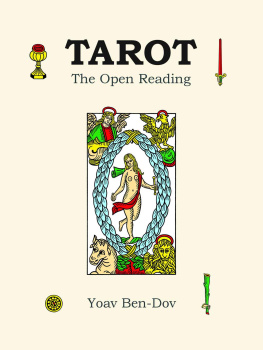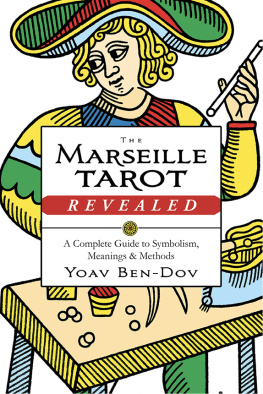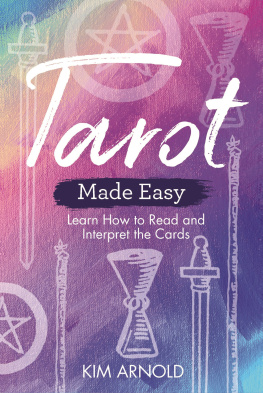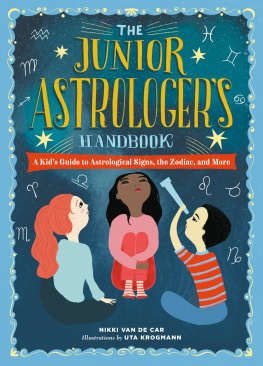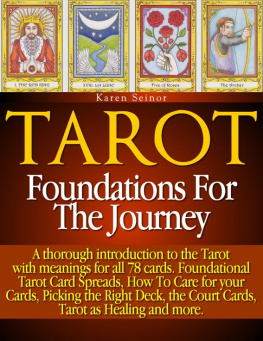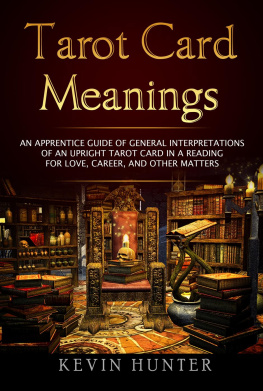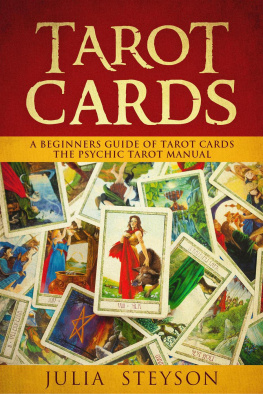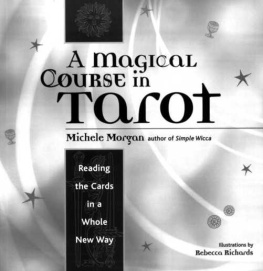Tarot The Open Reading
Yoav Ben-Dov
Text copyright:
2013 Yoav Ben-Dov
card illustrations copyright:
2011 Yoav Ben-Dov
cards published as:
CBD Tarot de Marseille
some parts of this text, all the card illustrations in color, and additional materials, appear on the website http://www.cbdtarot.com . The materials on the cbdtarot website are distributed under a Creative Commons license CC BY-NC-SA 3.0 , meaning that they are available for non-commercial use without need of further permission. See there for more details and exact conditions.
For other parts of the text, all rights reserved under the applicable copyright laws.
TABLE OF CONTENTS
Quick Interpretations:
Card Index :

A ll the card illustrations in color, additional materials to read and download, updates, and instructions for ordering a deck of CBD Tarot de Marseille are available at the website http://www.cbdtarot.com .
INTRODUCTION
There is magic in the Tarot.
Originally popularized as a humble means for playing games of chance, for several centuries this mysterious set of 78 cards has captured the imagination of countless people. Some have used the cards as an instrument for divination and fortunetelling. Others have seen the Tarot as a secret repository of ancient and powerful knowledge. Today many people use the Tarot cards as a tool for consultation, guidance, and decision-making. There are also those who employ them as a visual aid for guided imagination and meditation, or as magical amulets. And in the course of these centuries, countless human lives have been touched, and sometimes transformed, by the reading of Tarot cards.
I have been with the Tarot for 34 years: reading for people, teaching, writing and experimenting. I am still learning the Tarot. The subtle intricacies of the illustration details continue to present me with surprises. New and unexpected meanings never cease to emerge. And I am still amazed whenever a person opens up and shares his or her most intimate feelings in a reading session, when just the right card appears for someone in need, or when an unexplained but meaningful coincidence (or synchronicity event) happens in the presence of the Tarot cards.
And yet, if asked what the Tarot is, I would say that first of all it is a work of art. Not like a painted picture, framed and hung as a finished product that cannot be changed. Rather it is a capricious set of images to be handled and played with, evolving over many generations through the collective efforts of deck creators and visionaries. It is a wonderful work of art, rich and flexible enough to span the entire range of human experience from our innermost feelings to the external events of everyday life. And it is through this art, in the details of the card illustrations, that the magic of the Tarot is revealed.
The object of this book is threefold. First, it is a general introduction to the Tarot cards and the reading process. As such it can be relevant whether you want to read the cards yourself, or if you are interested in Tarot reading as a psychological device, as a cultural phenomenon, or as a way to find meanings in a work of art. Second, it is a guide for a method of Tarot reading that I call the open reading, based on looking at the card illustrations rather than learning fixed interpretations by heart. The open reading can be applied to different kinds of Tarot cards, although it works with some more effectively than with others. Third, it is a handbook for reading the Tarot de Marseille, which is the classical version of the traditional Tarot. In particular it uses the CBD Tarot de Marseille, an edition of the cards that I restored from the most influential historical deck originally published by Nicolas Conver in 1760.
Welcome.
CHAPTER 1: THE TAROT DECK
A deck of Tarot cards contains 78 cards. These can be divided into two parts. The first part is called the major suit. It consists of 22 cards with elaborate illustrations, numbered consecutively and having a specific name for each one. The major suit cards show images of people and animals along with many objects and symbols. Some of these are taken from social life. Others represent mythological, religious or philosophical themes.
The remaining 56 cards are further divided into four suits. These are called the minor suits, and have a simpler design than the 22 majors. The four suits are named after four symbolic objects: coins, wands, cups, and swords. Each of the minor suits consists of 14 cards of three types: one ace card, nine numbered cards (from 2 to 10), and four court cards identified by their rank: page, knight, queen and king. The minor suits structure is thus quite similar to normal playing cards which also have four suits. The main difference is that playing cards have only three court cards: jack, queen, and king.
Tarot literature sometimes use different names for the deck parts. The major and the minor suits are sometimes called major and minor arcana (from Latin arcanum, mystery). The major suit cards are also called trumps (triumphs), while the aces and numbers are sometimes referred to as pip cards.

The Magician, 6 of Coins, Ace of Wands, Knight of Cups, 3 of Swords
Origin of the Tarot
Questions about the original creator of the Tarot deck, the time and place of its creation, the significance of its complex symbol s, and even the origin of the name Tarot have long been debated, inspiring serious scholarship as well as wild speculation. Most historians today believe that Tarot cards first appeared in northern Italy around the beginning of the 15th century. They also suggest that the Tarot has undergone significant changes before stabilizing into the form we know today.
The two parts of the deck probably come from different sources. The minor suits are believed to have originated from playing cards, first used in China. These were later propagated in India, before reaching Italy through the Islamic countries in the late middle ages. Indeed, China and India have old games of cards with suits consisting of aces, numbered cards, and court cards. Muslim playing cards from the Mamluk period even show suit symbols which are visually very similar to the four Tarot suit symbols.
The major suit, on the other hand, appears to be a European invention. There is nothing similar to it in Asian countries, and its imagery clearly points to late European medieval or early renaissance influences. Historical records do not provide us with any hint as to why it was created, or how it became united with the four-suit playing cards coming from the East. What we do know is that from the 15th century onwards the combined Tarot deck, consisting of both the major and the minor suits, was widely used for playing games of chance in both aristocratic and popular circles.
It is also unclear as to why the combined deck has become known as the Tarot. Several hypotheses exist. My favorite one links the name Tarot to the word taroccho, which in common 16th-century Italian meant fool, a dumb person. This could, of course, be understood negatively as suggesting that only fools spend their time and money on card games such as Tarot. But we can also think of other interpretations. In the major suit there is one card called The Fool. It is often considered special and has a unique status in the suit, as we shall see . The original meaning of the name Tarot cards may thus have been the Fool s cards, referring to this particular card or to the figure appearing on it.

